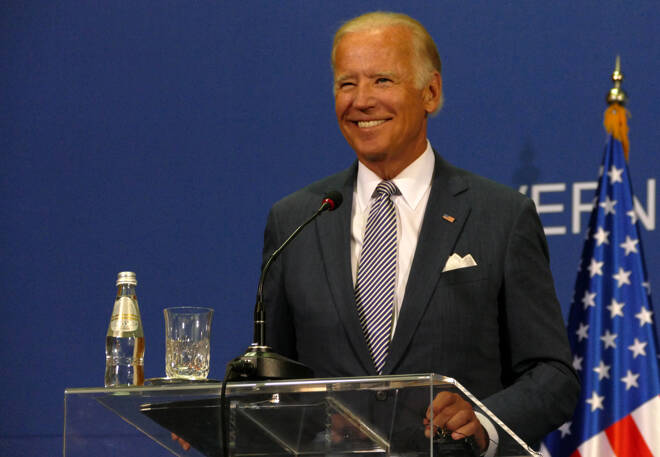Advertisement
Advertisement
US Recovery Plan Will Support Recovery and Raise Long-Run Economic Growth Potential From 1.9%
By:
President Joseph Biden’s recovery plan will provide substantial budget support for the recovery and tackle important structural bottlenecks. But a return to a more sustainable fiscal position after the crisis remains crucial.
Since the USD 1.9trn American Rescue Plan was signed into law in March, the Biden administration is pursuing two complementary pillars of its three-pillar “Build Back Better” agenda: i) the American Jobs Plan (with an earlier bipartisan compromise around a curtailed USD 1.2trn over eight years before recent setbacks), and ii) the American Families Plan (proposed USD 1.8trn).
The American Jobs Plan channels public funding towards enhancing physical and digital infrastructure, investing in research and development, shoring up supply chains and strengthening care systems. The American Families Plan aims to significantly raise federal spending in priority areas such as childcare, paid leave, pre-kindergarten, community college and healthcare.
The recovery plan is important not only for economic recovery but also for addressing structural bottlenecks
The administration’s programme is critical not only to provide near-term support for the economic recovery but also to address long-standing structural bottlenecks in the US economy. By enhancing the economy’s productive capacity, supporting domestic demand and tackling infrastructure deficits as well as structural weaknesses with respect to the social safety net, the programme supports a more inclusive and sustainable economic rebound and raises economic growth potential.
In our June 2021 Sovereign Interim Outlook, Scope Ratings projected the US economy to recover robustly, with 6.2% growth in 2021 (raised 2.2pps from our December 2020 projections) before 4.8% in 2022. After the 3.5% economic contraction of 2020, GDP is expected to have exceeded pre-crisis output as of Q2 2021, well ahead of the pace of recoveries in most European economies, including that of France and the United Kingdom. On the basis of the public investment programme, there is upside risk to our department’s prevailing US growth potential estimate of 1.9% – with potential output growth having otherwise seen secular decline since the turn of the century.
The spending programme comes at significant fiscal cost
The spending programme comes at a significant fiscal cost, however. The Committee for a Responsible Federal Budget estimates that the comprehensive package may amount to an aggregate of USD 6.7trn over 10 years. The US government has proposed offsetting measures such as an increase in the corporate income tax rate from 21% to 28%, enhanced tax enforcement and higher taxation of high-income households. These measures might generate savings of USD 3.3trn, leaving USD 3.5trn of unfunded costs, absent further revenue-raising measures.
In addition, mandatory expenditure linked to the healthcare system is likely to increase given the increase in federal spending on Medicaid and Medicare due to the Covid-19 health crisis and as more Americans seek benefits under programmes, barring reforms of the system.
US public debt to rise further, but accommodative financing conditions manage costs of borrowing
Presently, we expect US public debt to rise to above 135% of GDP in forthcoming years, from 108% in 2019 and only 65% as of 2007, exacerbating public finance weaknesses and stressing the United States’ AA credit ratings. Gross government financing requirements are estimated to stay around or above an elevated 40% of GDP per year through 2026. At the same time, prevailing accommodative financing conditions mitigate costs of borrowing, with 10-year government yields having backtracked to around 1.2% amid concern of a slowdown in the global recovery, from March highs of nearly 1.8%.
While benefits of a well-tailored investment programme at this stage are high and the cost of debt is low, it is critical that additional debt incurred nonetheless translates to tangible improvements of growth potential and addresses structural bottlenecks such as rising social inequality and problems of social mobility.
A return to a more balanced budget position remains crucial to ensuring benign funding costs and as the debt ceiling looms
While the United States still has meaningful fiscal space due to the dollar-based global financial system and the unparalleled status of US treasuries as the international risk-free asset, a return to a more balanced budget position after this crisis and reduction of contingent liabilities are nonetheless crucial to ensuring continued benign funding costs, especially as the Federal Reserve considers its exit strategies from crisis policies and as elevated deficits present risks after coming reinstatement of the US debt ceiling.
For a look at all of today’s economic events, check out our economic calendar.
Dennis Shen is a Director in Sovereign and Public Sector ratings at Scope Ratings GmbH. Thibault Vasse, Senior Analyst at Scope Ratings, contributed to writing this commentary.
About the Author
Dennis Shencontributor
Dennis Shen is the Chair of the Macroeconomic Council and Lead Global Economist of Scope Ratings based in Berlin, Germany.
Advertisement
